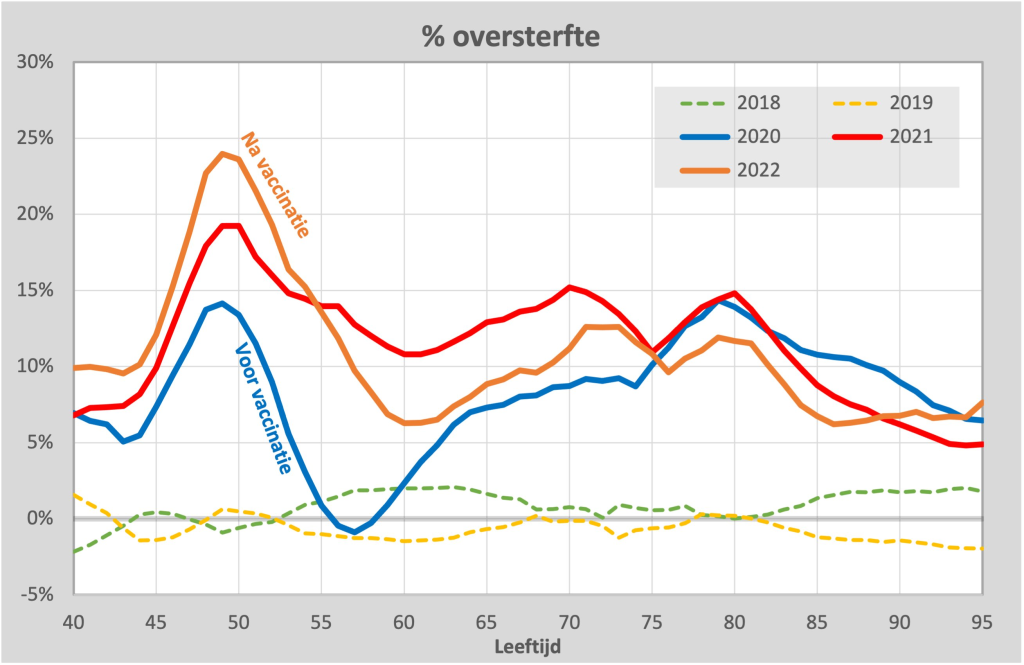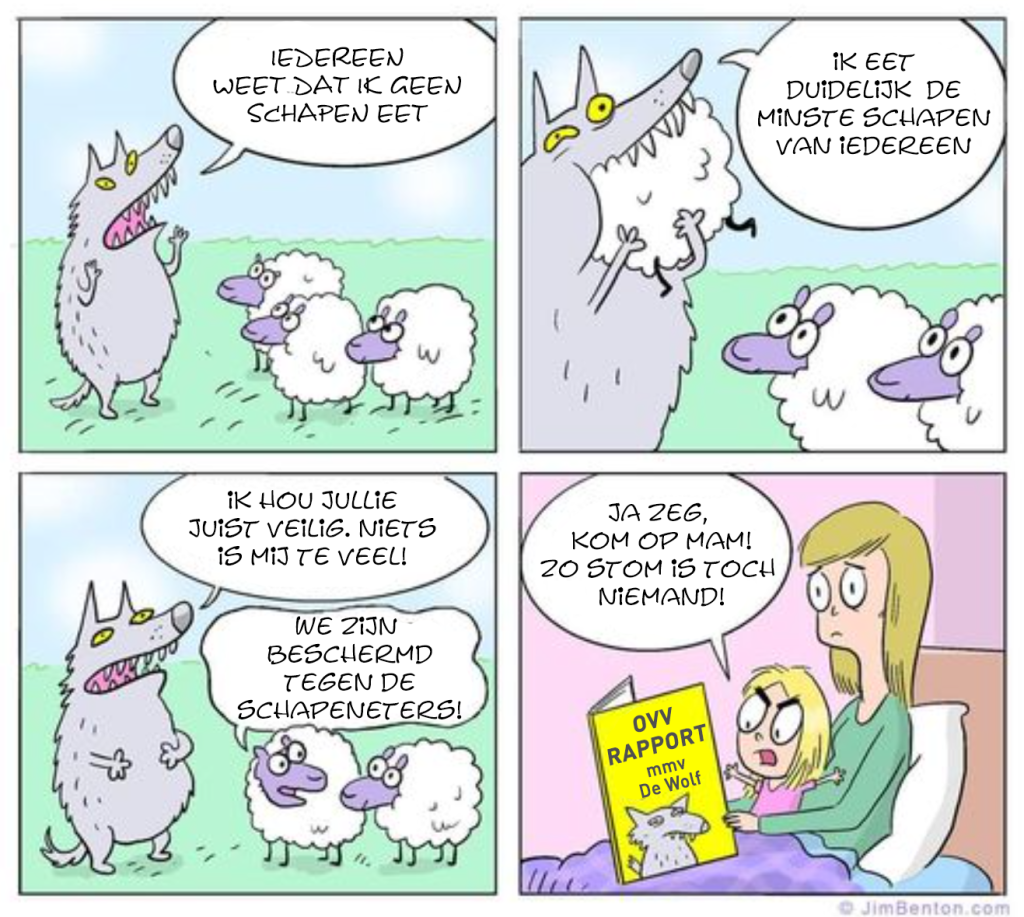The Dutch Safety Board has written a book of fairy tales under the watchful eye of Willy Spaan, Alma Tostmann and Chantal Rovers, among others. The latter two had already distinguished themselves (see The propagandists of the government) and we are considering compiling an anthology of Willy Spaan that gives an impression of his insights.
Maurice gives an impression of the report's mind-boggling omissions. 'Safety' is apparently not measured by the number of people who die, because we don't see anything about that in the report.
As far as (excess) mortality is concerned: Herman Steigstra has a wealth of graphs and analyses that visualize the figures from CBS and RIVM. I like this, for example: look up your own age on the X-axis and see how the excess mortality in your age group compares to the normal, expected mortality. The dotted lines give an impression of the course in pandemic and vaccination-free years.
Now, I haven't read the report myself and I'm not going to waste time on it. I am now familiar with the 'analyses' of Operation Money Laundering. I therefore quote a fellow critic who has looked at the report. He mentions three sensible points from which I conclude that the report is in line with my expectations:
- Totally ignoring the fact that the RIVM models were completely wrong with their predictions time and time again. Previous panic/code-black predictions never came true, reality never even came close to it. And if I remember correctly, the story of RIVM/OMT and companions was in the summer of 2021 and well into the autumn: the leak is now over, so many people have now been vaccinated, its protection is so good, that we will no longer run into problems this winter!
And then suddenly, in November 2021, the number of infections turned out to be rising sharply again and suddenly the story, and the RIVM predictions, changed. Which prediction from the RIVM should we have listened to exactly? The important lesson should be correct: those predictions, time and time again, were wrong. - This piece still suggests that the strict measures were actually very necessary, and justified; And that if we had been earlier with measures, we could have been less strict. But there is no indication of that. Again, it wasn't too bad with how bad it was going to be in the hospitals, and they should have known that. Indeed because of the information about Omicron, but also because it wasn't too bad every time, after the first wave. Now the story is accepted again: it wasn't so bad THANKS to the measures.
This reminds me a lot of the UK Covid Inquiry, where the story of the SAGE zealots is also: the strict measures were necessary and good; And if we had been a little stricter earlier, it could have been a little less strict a little later because we could have suppressed it earlier. 'And so next time we have to intervene a little harder (it's good that we now have the WPG's toolbox!), we have to listen to "the science" earlier and better'.
I think the lesson is: the waves come as they come, measures or not. And in terms of hospitalizations, it's getting a little less bad with each wave. Due to growing herd immunity; and it seems to be mainly driven by building NATURAL immunity. And perhaps a bit because the virus mutates into milder variants (which is also common). - Totally ignoring the fact that the sharp rise in infections at the end of 2021 completely undermines the original narrative that the vaccines are actually 'sterilizing' ("95% protected against infection after vaccination"). And the fact that there are very strict measures again also says that people no longer believe in the story, repeated throughout 2021 and all years since, that the vaccination protects very well against hospitalization and serious illness.
Why all these measures when those vaccines work so great, and 85% of the population is fully vaccinated (basic series i.e.g.) and 93% of the elderly and vulnerable? Oh, I get it, not 'up to date', too late with the "booster", and actually not so surprising that such a "booster" (oh no, now it's "annual booster shot") is necessary? Great, this is a completely different story than has been told all along. The scientists and doctors should have told us this earlier.
You can fill in who the sheep are in the accompanying cartoon.
(Idea of ©Jim Benton, text modification of mine.)
How do we keep ourselves safe in the event of the next pandemic crisis?
"We should not make the mistake of only wanting to learn from the past", according to Ron Fouchier. He literally says: "What worries me the most is that we're always preparing for something based on our historical experiences."
If you didn't know any better, you'd think it's a prelude to a grant application: virological research should undoubtedly point the way in the right direction. After all, virologists have a razor-sharp eye on the dangers they see coming suddenly become reality, just look at the research in the Wuhan lab: center of research into coronaviruses. And what breaks out? A coronavirus. So they had seen that right.
Peter Daszak, who channelled American funds to Wuhan through the 'Eco Health Alliance' foundation, also claimed in March 2021 that they had repeatedly warned of a bat coronavirus outbreak in China. They knew that from the risk assessments they did in China. He has been keeping a low profile for some time.
In the context of predictions, it is frightening that Fouchier foresees problems with viruses that cause neurological damage. In an interview, he complains about the restrictions imposed on him. He mentions the "risk assessments" that are done based on Gain of Function research. In GoF research, possible future evolutionary developments are set in motion by mixing dangerous virus traits. Serial passaging (a series of animal-to-animal infections) allows the lab creations to adapt to mammals, among other things. Contamination of humans is therefore getting closer, especially with additional tinkering that targets human receptors. Based on this, it can be assessed how threatening these 'future' viruses may be to humans.
Consider, for example, the contagiousness of Omicron and the damage of polio. Fouchier would like to see a risk assessment of this, but he can only do that once the virus exists. To do this, it must first be manufactured.
In short: more virus experiments should keep us safe in the future.
"Viewing transfer in an animal model is permitted. We can do risk assessments. It's harder for us to really explore the future of this evolutionary trajectory or new traits that we don't have a good sense of, like neurovirals, you see? I find it an intriguing question why current viruses cause so many neurological symptoms in poultry, wild birds and mammals alike. But I think that's still something that's difficult to investigate in the American programs at the moment. We can still do it in Europe or Asia, but in the U.S. it's a bit tricky at the moment."
Original English excerpt:
The last sentence is literally: "We can still do it in Europe or in Asia, but in the US it's a little bit tricky at the moment."
So he's not saying it's banned in the U.S., or that it's not possible or not being implemented. He describes the research being done there as "tricky". He is not concerned with the dangers that such research entails. "Tricky" means that you have to work around something, that the research in the US is risky, that it is very precise, unlike in China and Europe. In short, they have to be extra careful when conducting that research in the US.
Are the labs there less secure? Well, no; it is simply forbidden. The virologists are therefore forced to do their research secretly, which they find quite disturbing. In China, things are much easier, as we have seen.
It is possible that the word 'tricky' escapes him because it is not always possible to find the right word in a second language. In any case, it exactly reflects the nonchalant toughness with which he speaks about that life-threatening investigation. Who would like a 'risk assessment' of a virus that causes severe, neurological - and therefore usually irreparable - damage, with the contagiousness of Omicron? For virologists, it means work. For military strategists, it opens up new possibilities, provided it comes with a proper vaccine. But beyond that, qui bono?
"We shouldn't make the mistake of only wanting to learn from the past."
Ron Fouchier on the usefulness of Gain of Function research
Lessons for the future...?
In Wuhan, they had been "investigating future evolutionary developments" for decades, a euphemism for Gain-of-Function research. This is quite a circus with heavy safety measures, continuous supply and removal of laboratory animals and special PCR tests to see when which animals are infected.
So that's the research we could learn from better than the past. The past had shown: don't do lockdowns, washing hands doesn't help, make sure you have clean air, use antibiotics against bacterial co-infections. All that knowledge has been thrown overboard. So far, Fouchier can be satisfied.
So it is a pity that the Chinese databases with crucial knowledge about that dawning future were immediately taken offline and that a German had to quickly put together his own PCR test on the basis of Twitter messages.
In short: What Ron Fouchier is trying to sell here has proven to be ineffective. One wonders whether this would have been different if corona had had a zoonotic origin.
The interview with Fouchier is part of a longer video. The interesting part is in the last five minutes, starting at minute 54. This link starts there.





To my surprise, Jan Bonte at DNW was mild about Fouchier and his associates. But I'm left with the image of a nutty professor who secretly wants to continue his work while that technique has killed 6 million people directly and many millions more indirectly through failed gene therapy.
I also found Jan remarkably mild. Koopmans works on him like a red rag on a mad bull, perhaps because she shows herself more. Behind the scenes, Fouchier is perhaps Koopmans squared in terms of content. With its 'tricky'. But he doesn't tweet.